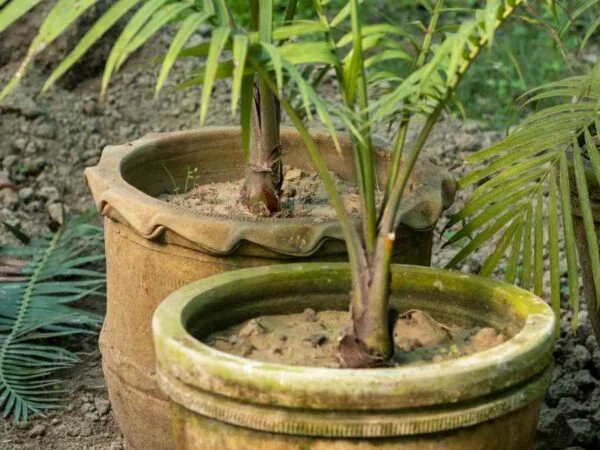Did you know that overwatering is a leading cause of areca palms turning yellow? This common houseplant issue can be frustrating, but fear not - there are simple solutions to revive your yellowing areca palm back to its vibrant green glory.
If you're facing the predicament of a yellow areca palm with green color roots, this blog post will provide you with practical tips and expert advice on how to identify the problem, adjust your watering routine, and promote healthy growth for your beloved plant. Say goodbye to yellow leaves and hello to lush green foliage by following our easy-to-implement suggestions. Let's get your areca palm thriving again!
Key Takeaways
- Understanding Yellowing:
- Monitor your areca palm for signs of yellowing leaves as it could indicate a potential cause with care or environment.
- Ideal Growing Conditions:
- Ensure your areca palm is placed in a well-lit area away from direct sunlight and in a humid environment to promote healthy growth.
- Nutrient Management:
- Regularly fertilize your areca palm with a balanced nitrogen fertilizer solution to provide essential nutrients for vibrant foliage.
- Pest and Disease Control:
- Keep an eye out for common pests like spider mites and scale insects, and promptly treat any infestations to prevent damage.
- Watering and Humidity:
- Maintain consistent watering schedule and humidity levels to prevent both overwatering and underwatering, which can lead to yellowing leaves.
- Routine Care and Maintenance:
- Regularly dust the leaves, trim brown tips, and inspect the plant for any abnormalities to ensure overall health.
Understanding Yellowing

Common Causes
Areca Palms turning yellow can be attributed to various factors, including inadequate light exposure. Neglect and poor environmental conditions can also contribute to the discoloration. The plant's health is greatly affected by these issues.
Environmental factors such as insufficient sunlight play a crucial role in Areca Palm yellowing. Lack of proper care, including irregular watering and humidity levels, can lead to the plant's leaves turning yellow. Neglecting these aspects impacts the overall well-being of the palm.
Nutrient Deficiencies
Recognizing signs of nutrient deficiencies in Areca Palms is essential for their health. Magnesium deficiency, in particular, can cause yellowing leaves and hinder the plant's vitality. Imbalances in essential nutrients can result in significant discoloration issues.
Magnesium, vital for Areca Palms' growth, plays a key role in maintaining their green hue. A lack of this nutrient can manifest as yellowing leaves, affecting the plant's appearance and health. Ensuring a balanced nutrient intake is crucial to prevent discoloration problems.
Pests Impact
Pests like spider mites and mealy bugs pose a threat to Areca Palms, especially when plants are under stress. Stressed palms are more susceptible to pest infestations, leading to further damage if left untreated. Preventive measures are necessary to protect the plant from these pests.
Understanding how pests impact Areca Palms is crucial for effective pest management strategies. Stress factors make plants more vulnerable to infestations, emphasizing the need for regular monitoring and treatment. Implementing preventive measures can safeguard the palm from potential damage.
Environmental Factors
The health of Areca Palms is significantly influenced by various environmental conditions, including light exposure and water availability. Maintaining optimal levels of light, water, and humidity is essential for promoting the plant's well-being. Creating a suitable environment is key to preventing yellowing issues.
Exploring how environmental factors affect Areca Palms reveals the importance of providing adequate light, water, and humidity levels. These elements directly impact the plant's health and growth, influencing its susceptibility to discoloration problems. By ensuring an ideal environment, you can help your palm thrive.
Ideal Growing Conditions

Light Requirements
Areca Palms require bright, indirect light to thrive, making them ideal for indoor spaces with filtered sunlight. Direct sunlight can scorch their leaves, leading to yellowing. To prevent discoloration, place your plant near a window with sheer curtains or use artificial grow lights.
Common mistakes like keeping the plant in low light areas can result in yellowing leaves. Ensure your Areca Palm receives at least 6-8 hours of light daily. Rotate the plant periodically to promote even growth and prevent one-sided yellowing.
Implement strategies such as pruning nearby foliage that may block light from reaching your plant. Consider using reflective surfaces to maximize light exposure for optimal growth and vibrant green foliage.
Watering Needs
Proper watering is crucial for Areca Palms to avoid yellowing. Overwatering can lead to root rot and yellow leaves, while underwatering causes dehydration and browning. Water your palm when the top inch of soil feels dry, ensuring adequate drainage to prevent waterlogging.
Maintain optimal soil moisture by using well-draining soil and pots with drainage holes. Avoid leaving stagnant water in the saucer beneath the pot, as it can lead to root suffocation and nutrient deficiencies. Allow excess water to drain completely before returning the pot to its decorative container.
Discover signs of overwatering, such as mushy stems and soggy soil, indicating the need to adjust your watering frequency. Implement a regular watering schedule based on environmental factors like humidity levels and season changes.
Humidity Levels
Humidity plays a vital role in Areca Palm health, influencing leaf color and overall vitality. Increase humidity levels by misting the leaves regularly or placing a humidifier near the plant. Maintain humidity above 50% to prevent leaf browning and yellowing due to dry air.
Understand the relationship between low humidity levels and moisture loss through transpiration, leading to stressed plants with discolored leaves. Consider grouping plants together or placing a tray of water near your palm to create a microclimate with higher humidity levels.
Explore natural ways to boost humidity, such as pebble trays filled with water placed beneath the plant or using a room humidifier during dry seasons. Monitor humidity levels regularly using a hygrometer to ensure optimal growing conditions for your Areca Palm.
Nutrient Management

Identifying Deficiencies
Areca Palms can suffer from nitrogen deficiencies, leading to yellowing leaves and stunted growth. Observe the older leaves turning pale green or yellow as a sign of nutrient deficiency. Act promptly to prevent further damage by providing the necessary nutrients.
Soil Amendments
Enhance the health of Areca Palms by incorporating fertilizers rich in nitrogen into the soil. Utilize iron-based fertilizers to address yellowing leaves caused by nutrient deficiencies. Consider adding Epsom salts to boost magnesium levels in the soil for optimal plant growth.
Pest and Disease Control
Common Pests
Pests that commonly affect Areca Palms include spider mites and mealybugs. These pests can cause yellowing leaves and stunted growth. Inspect your plants regularly for any signs of infestation such as webbing or sticky residue. Neem oil is an effective natural remedy for controlling these pests.
- Spider mites
- Mealybugs
- Inspect regularly
- Neem oil remedy
Disease Prevention
Preventing diseases in Areca Palms is crucial for their overall health. Ensure proper air circulation around the plant to reduce the risk of fungal infections. Avoid overwatering as it can lead to root rot, a common disease in Areca Palms. Creating a disease-resistant environment involves maintaining optimal humidity levels and avoiding waterlogged soil.
- Air circulation
- Avoid overwatering
- Optimal humidity levels
Watering and Humidity
Adjusting Watering
Overwatering Issues
- Recognize the signs of overwatering in Areca Palms, such as wilting leaves and yellowing fronds.
- Excessive moisture can suffocate roots, leading to nutrient deficiencies and yellowing leaves.
- To avoid overwatering, adjust your watering routine by allowing the soil to partially dry out between waterings.
Underwatering Signs
- Symptoms of underwatering include drooping leaves and brittle, yellow fronds on Areca Palms.
- Insufficient water can cause stress to the plant, resulting in stunted growth and yellowed foliage.
- Properly hydrate your plant by ensuring that the soil is evenly moist but not waterlogged to prevent yellowing.
Humidity Solutions
- Effective solutions for increasing humidity around Areca Palms include grouping plants together, using a humidifier, or placing a tray of water nearby.
- Creating a humid environment without overwatering involves misting the leaves occasionally or using a pebble tray filled with water.
- Maintain optimal humidity levels indoors by monitoring levels with a hygrometer and adjusting based on plant needs.
Light and Placement
Light Adjustment
Areca Palms require adequate light exposure to thrive but can be sensitive to excessive sunlight. Protect your plant by adjusting the light levels gradually. Avoid direct sun exposure, especially during the hottest parts of the day.
To prevent your Areca Palm from turning yellow due to too much light, consider filtering sunlight with sheer curtains or placing it in an area with bright, indirect light. This will provide the plant with the necessary light without causing harm.
Ensure your Areca Palm receives indirect sunlight for most of the day. Consider rotating the plant occasionally to ensure even light distribution and prevent any part from being overexposed.
Optimal Placement
For optimal growth, place your Areca Palm in a spot that receives bright, indirect light. Avoid placing it in direct sunlight as this can lead to leaf burn and yellowing.
Position your plant near a window where it can receive filtered sunlight throughout the day. Ensure that the light is not too harsh or direct, especially during peak hours of sunlight exposure.
Indoor placement options include near east or west-facing windows where the plant can benefit from morning or late afternoon sun. Outdoor placement considerations involve choosing a shaded area with indirect sunlight to protect the plant from intense heat.
Routine Care and Maintenance
Pruning Tips
Pruning plays a crucial role in maintaining the health of Areca Palms. Removing damaged or yellow leaves not only enhances the plant's appearance but also stimulates new growth. By pruning regularly, you can ensure that your plant remains healthy and vibrant.
To effectively prune your Areca Palm, it is essential to understand the proper techniques. Begin by identifying any damaged or yellow leaves, then carefully trim them off using sharp, clean scissors or shears. Ensure that you make clean cuts to prevent further damage to the plant.
Cleaning Leaves
Keeping Areca Palm leaves clean is vital for plant health. Dust and debris can accumulate on the leaves, hindering the plant's ability to photosynthesize effectively. Regularly cleaning the leaves not only improves the plant's appearance but also helps it thrive.
Simple methods such as gently wiping the leaves with a damp cloth or spraying them with water can effectively remove dust and debris. For more stubborn dirt, consider using a mild soap solution to clean the leaves thoroughly. By incorporating leaf cleaning into your routine care, you can support your Areca Palm's overall well-being.
Monitoring and Adjustments
Tools for Health Monitoring
To ensure the optimal health of your Areca Palms, utilize essential tools like moisture meters and magnifying glasses. These tools help in closely monitoring the plant's condition and detecting any issues early on. Regular health checks are crucial to maintaining a thriving plant.
- Moisture meters: Measure the moisture levels in the soil to avoid overwatering or underwatering.
- Magnifying glasses: Aid in inspecting the leaves for pests, diseases, or any abnormalities.
- Regular health checks: Conduct these checks periodically to address any problems promptly.
Environmental Adjustments
Make necessary adjustments to create a favorable environment for your Areca Palms. Modifying light exposure, watering frequency, and humidity levels can significantly impact the plant's well-being. Adapt your care routine based on seasonal changes to support optimal growth.
- Light modification: Ensure your plant receives adequate but indirect sunlight to prevent leaf burn.
- Water adjustments: Water your Areca Palm thoroughly but allow the topsoil to dry out slightly between waterings.
- Humidity control: Maintain a humid environment by misting the leaves regularly or using a humidifier.
- Seasonal strategies: Adjust care practices such as watering frequency and fertilization according to seasonal variations.
Preventive Measures
Routine Checks
Regular checks are crucial for Areca Palm health. Inspect your plant frequently for signs of stress or disease. Establishing a routine maintenance schedule offers various benefits.
Seasonal Adjustments are necessary for Areca Palms. Adapt care routines according to seasonal changes. Different seasons impact plant health and growth differently.
Closing Thoughts
In caring for your areca palm, remember that yellowing leaves signal underlying issues that require attention. Ensure optimal growing conditions, maintain nutrient levels, and be vigilant against pests and diseases. Proper watering, humidity, light exposure, and placement are vital for your plant's health. Regular monitoring and adjustments will help you prevent problems before they escalate. By following these guidelines, you can keep your areca palm vibrant and lush.
Take proactive steps to address any yellowing promptly and implement preventive measures to sustain your plant's well-being. Your dedication to providing the best care will result in a thriving and beautiful areca palm in your indoor oasis.
Frequently Asked Questions
How can I prevent my areca palm from turning yellow?
To prevent yellowing, ensure your areca palm receives adequate sunlight, water it appropriately, maintain proper humidity levels, and regularly fertilize it. Monitor for pests and diseases, adjust care routines as needed, and follow preventive measures to keep your plant healthy.
What are the ideal growing conditions for an areca palm?
Areca palms thrive in bright, indirect sunlight with temperatures between 65-75°F (18-24°C). They prefer well-draining soil that is kept consistently moist but not waterlogged. Maintain high humidity levels of around 50-60% and avoid exposing the plant to drafts or temperature extremes.
How should I manage nutrients for my areca palm?
Fertilize your areca palm every 2-3 months during the growing season using a balanced liquid fertilizer diluted to half strength. Ensure the plant receives essential nutrients like nitrogen, potassium, and magnesium to support healthy growth and vibrant foliage.
What pest and disease control measures should I take for my areca palm?
Regularly inspect your plant for common pests like spider mites and scale insects. Treat infestations promptly with neem oil or insecticidal soap. Prevent diseases by avoiding overwatering, providing good air circulation, and promptly removing any dead or decaying foliage.
How should I adjust watering and humidity levels for my areca palm?
Water your areca palm when the top inch of soil feels dry, ensuring thorough but not excessive watering. Maintain moderate to high humidity levels by misting the leaves or using a pebble tray filled with water. Adjust watering frequency based on environmental conditions to prevent yellowing.
Image Source: Paid image from CANVA





